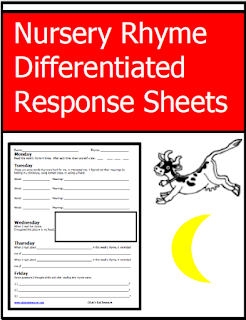As a teacher at an International School, many of my students are English Language Learners. Even my native English speakers are living in a non-English speaking country. Due to my unique teaching position, I have had some readers ask for tips on teaching English Language Learners. Here is this week’s Tuesday TESOL Teaching Tip:
ELL Teaching Tip #39: Teach Nursery Rhymes and FolktalesNursery Rhymes and Folktales are the kinds of background knowledge we often assume our students come to school with. Of course they’ve heard of Jack and Jill, who hasn’t heard of Jack and Jill – right?
 Wrong. Many of our English Language Learners are not familiar with common rhymes and stories in English. While this doesn’t seem like a big deal, many books, poems, movies, t.v. shows and songs make references to nursery rhymes and folktales that are part of the English speaking culture. Think of the Shrek movies. If you aren’t familiar with common nursery rhymes and folktales, you won’t understand the jokes in these movies at all, and while understanding this movie isn’t vital to learning English, there are many other examples of important texts that rely on this “assumed” background knowledge. These texts are common on standardized tests because again it’s an assumption that most students will have familiarity with these themes and stories.
Wrong. Many of our English Language Learners are not familiar with common rhymes and stories in English. While this doesn’t seem like a big deal, many books, poems, movies, t.v. shows and songs make references to nursery rhymes and folktales that are part of the English speaking culture. Think of the Shrek movies. If you aren’t familiar with common nursery rhymes and folktales, you won’t understand the jokes in these movies at all, and while understanding this movie isn’t vital to learning English, there are many other examples of important texts that rely on this “assumed” background knowledge. These texts are common on standardized tests because again it’s an assumption that most students will have familiarity with these themes and stories.Here are some suggestions on ways to include nursery rhymes and folktales into your classroom in order to give your students this background knowledge that the native English speakers are more likely to already have. (As a side note, I have had many native English speakers who lack this background knowledge as well, often depending on their home life and socio-economic status.)

- Choose a nursery rhyme a week for students to memorize. Print the rhyme, let students glue it into a notebook and illustrate it. Talk about words and phrases that aren’t commonly used anymore. ie. Why did Jack “plaster his head with vinegar and brown paper?” Recite the nursery rhyme each morning, or as you are lining up or during other transition times. Nursery rhymes are a great way to work on fluency and vocabulary. In addition, I've put together these free Nursery Rhyme Response Sheets which will incorporate reading strategies and vocabulary.
- Do a unit on folktales around the world. Start by choosing 2 or 3 common folktales from the English speaking cultures (Little Red Riding Hood, Cinderella, The Three Bears etc.) Find, or let students find, other stories with the same common themes from cultures around the world. Encourage students to find a story from their own language/culture which has a common theme. Create graphic organizers to compare and contrast different folktales.
- Use Aesop’s Fables – Many cultures use Aesop’s
fables, so these many be familiar to your students. Take the time to see if students are familiar with these stories. Encourage them to read a fable to the class in their home language (or find a video for younger students). Then read the fable in English. Talk about the vocabulary that can be pulled from the fables. (ie. race, trick, moral etc.) Feel free to grab my Tortoise and the Hare Reader’s Response Packet for Free from my TPT store.
How do you use nursery rhymes and folktales in your classroom?
![Everythings-Intermediate-Expo7222232[1] Everythings-Intermediate-Expo7222232[1]](https://blogger.googleusercontent.com/img/b/R29vZ2xl/AVvXsEhLZ-QFMmp2ugwAqSiiwnf0rGlrK-9UAHaSzBBO_b7guYtBpC8HSx4izyY0UeBmmyCoygVcSTKtMEu7wJcGO79Ldvael6zwN43RzE1wsIfqJ2jx3qPtPpJAFJdxmeBH-Ycy4LhQ45fVzn5i/?imgmax=800) Do you enjoy the weekly TESOL Teaching Tips? Would you like to view an hour long presentation on this topic? I recently presented on Strategies for Teaching English Language Learners at the Everything’s Intermediate Expo. Now you can grab the presentation for just $3.95 from Teacher’s Notebook.
Do you enjoy the weekly TESOL Teaching Tips? Would you like to view an hour long presentation on this topic? I recently presented on Strategies for Teaching English Language Learners at the Everything’s Intermediate Expo. Now you can grab the presentation for just $3.95 from Teacher’s Notebook.Find more TESOL Teaching Tips here, and come back every Tuesday for a new tip!




No comments:
Post a Comment